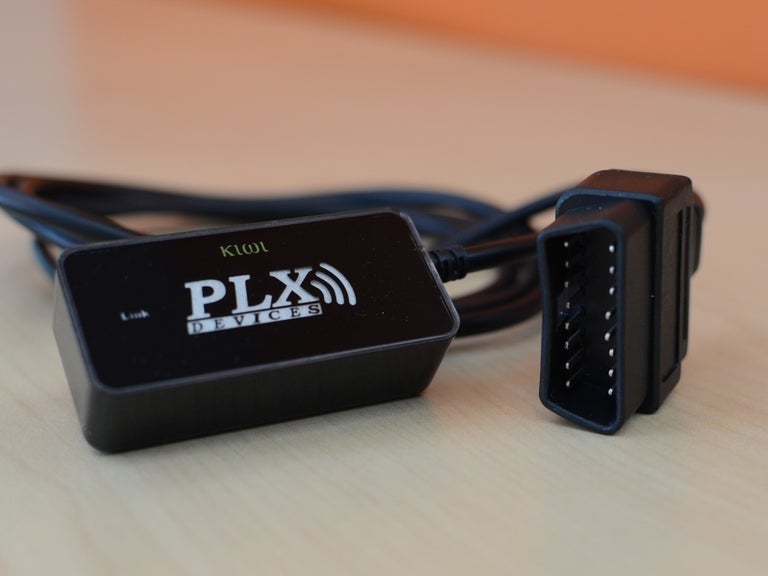 Why You Can Trust CNET
Why You Can Trust CNET PLX Kiwi Bluetooth review: PLX Kiwi Bluetooth
With the help of PLX Devices' Kiwi Bluetooth and your diagnostics app of choice, you can monitor your car's horsepower, torque, and fuel economy with your Android-powered smartphone.
The PLX Kiwi Bluetooth is a simple device that only does one thing: act as a bridge between your Bluetooth-enabled Android phone and your car's onboard diagnostics port (OBD-II). The 1.25 inch tall by 2.75 inches wide by 0.7 inch deep glossy black plastic box features little more than the PLX Devices logo and a small connection status LED marked "LINK" on its top surface and a tiny power switch on one side.
The Good
The Bad
The Bottom Line
Installation and setup
The Kiwi Bluetooth unit connects to your car via a 6-foot cable with a standard 16-pin OBD-II connector at the other end. That's a generous length of cord for a wireless device, but it's better to have more than you need than not enough to reach. I suppose that the long cord could come in handy, if you wanted to mount the Kiwi Bluetooth somewhere visible. However, PLX has neglected to include any sort of mounting hardware or accessories, so bring your own zip-ties or double-sided tape, attach the Kiwi Bluetooth to the underside of your dashboard, and forget it.
PLX recommends that you connect the Kiwi Bluetooth to your car before starting the engine. With the motor running, the PLX Devices logo on the Kiwi's face should glow blue to indicate that the device is active.
From here, you'll finish setup on your Bluetooth-enabled Android smartphone. Jump to the Settings menu, then the Wireless & networks submenu and finally select Bluetooth settings. Scan for Bluetooth devices and select the PLX Device from the list when it appears. You'll be prompted to input the four-digit PIN that is provided in the manual that accompanies the Kiwi Bluetooth. The device and your handset will then be paired and able to communicate with each other.
Performance and apps
By itself, the Kiwi Bluetooth doesn't do very much. However, as an interface for third-party vehicle-monitoring apps, the device allows your phone to monitor dozens of OBD-II parameters. It is only limited by which parameters are reported by your car's diagnostics system. In most vehicles, you'll get engine rpm, vehicle speed, coolant temperature, intake air temperature, engine load, and many more. Engines that use forced induction may report boost pressure. Additionally, if your Check Engine light is illuminated, the Kiwi can relay the trouble code.
In order to make use of any of this data, you'll need a diagnostics app for your Android phone. Fortunately, there are many free and paid apps available in the Google Play Store. PLX itself recommends that you take a look at Torque (free Lite version, $4.95 Pro version), alOBD Scanner (free, $4.99 Pro version), VoyagerDash ($1.00), OBDroid (which I couldn't actually find in the Google Play Store), or Dash Command (by far the most expensive at $49.95), as all of these apps have been verified to work. All of these apps will be able to display the raw OBD-II data as gauges, graphs, or numerical readouts, but some will be able to take that data to calculate values such as torque, horsepower, or fuel economy.
I tested the Kiwi Bluetooth with the basic, free Torque Lite and found that the Kiwi performed exactly as advertised. The phone's interface makes setting up the gauges that I want to see much more intuitive than fiddling with buttons on the tiny-screened standalone OBD-II loggers that I've tested previously. Your experience will vary depending on what app you choose to use in concert with the Kiwi Bluetooth, so try them all and pick the one that best fits your needs.
Additionally, I staged a fault code by removing the test vehicle's fuel cap and driving for a few miles, which caused the check-engine light to illuminate. The Torque Lite app popped up the trouble code on screen. Although it didn't tell me exactly what the code meant, a quick Google Search found the answer, "Missing or loose fuel cap." Replacing the cap and driving a bit farther cleared the code without an expensive trip to my mechanic.
Price
The PLX Kiwi Bluetooth for Android phones retails for $99.99. That puts the Kiwi and the most expensive recommended app well below the price point of many standalone OBD-II scanning devices that we've tested, which tend to be in the $200-to-$250 range. With the Kiwi device and its apps, users gain a great deal of flexibility and, since you can easily take your phone and the data you've logged with you upon exiting the vehicle, a great deal of portability compared with these standalone devices. And if the Kiwi can save you from one trip to the mechanic over something so small as a lost fuel filler cap, it'll have paid for itself. At the very least, it will allow you to enter the Service department armed with a bit more knowledge. DIYers, enthusiasts, tinkerers, and modders will also find value and fun in the data the Kiwi pipes to their devices.
Users of Apple's iOS software can get a similar functionality from the PLX Kiwi Wifi, which retails for $149.99 -- a reasonable price, but not as good a deal as the Bluetooth model.


